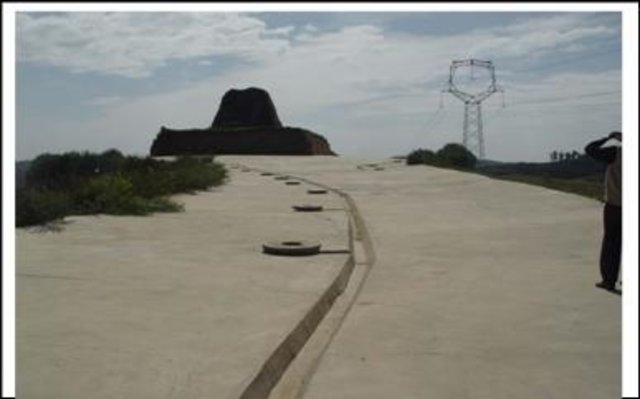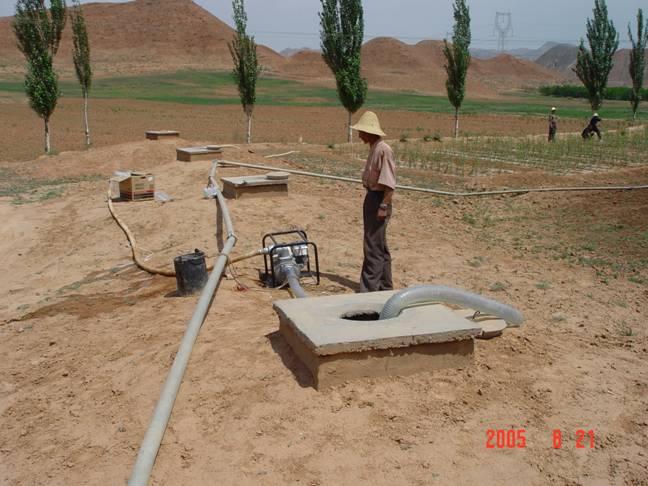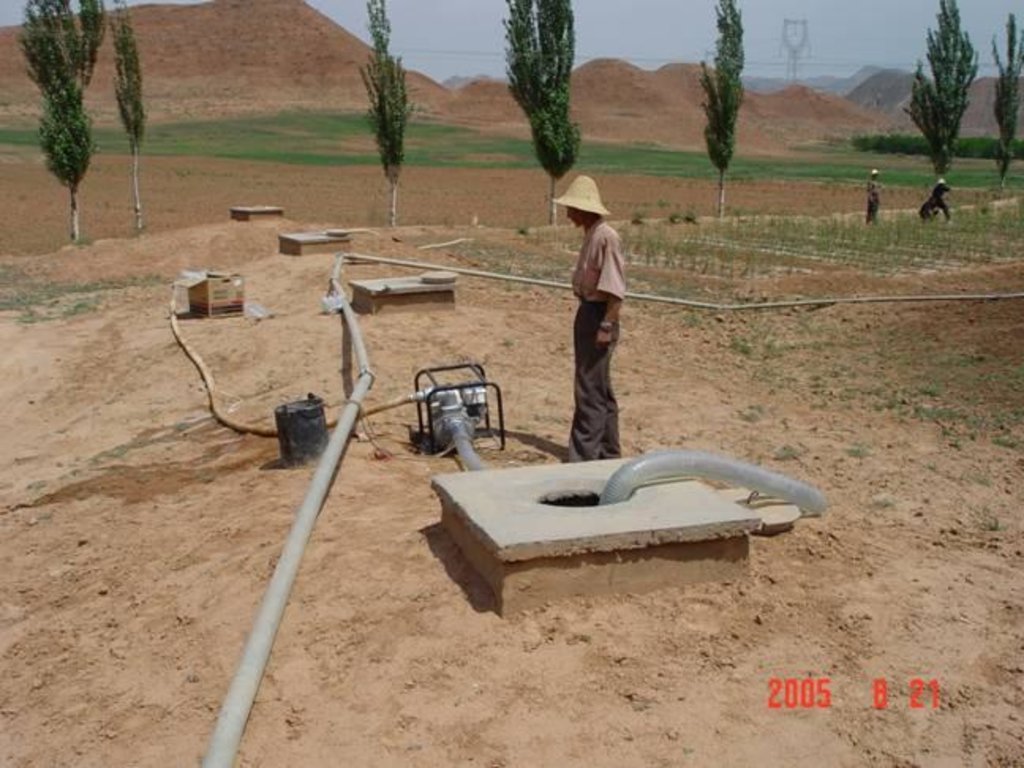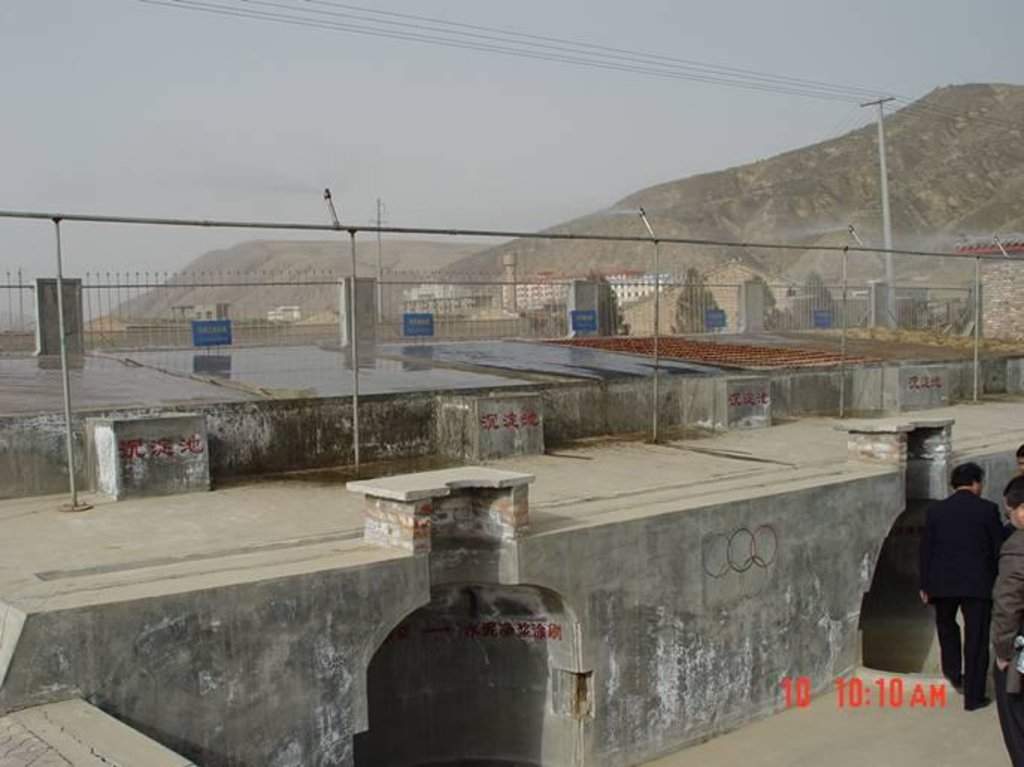Rainwater Cellars introduced through government support [China]
- Criação:
- Atualização:
- Compilador/a: Anna Schuler
- Editor: –
- Revisor: Laura Ebneter
approaches_2432 - China
Veja as seções
Expandir tudo Recolher tudo1. Informação geral
1.2 Detalhes do contato das pessoas capacitadas e instituições envolvidas na avaliação e documentação da abordagem
Especialista em GST:
Wang Yaolin
GEF/OP12 Project Implementation Office of Gansu (Gamsu Sand Control Research Institute)
Chen Zhengbin, Forestry Bureau of Anding District, Dingxi City, Gansu Province
China
Nome da(s) instituição(ões) que facilitou(ram) a documentação/avaliação da Abordagem (se relevante)
CDE Centre for Development and Environment (CDE Centre for Development and Environment) - SuíçaNome da(s) instituição(ões) que facilitou(ram) a documentação/avaliação da Abordagem (se relevante)
GEF/OP12 Gansu Project (GEF/OP12 Gansu Project) - China1.3 Condições em relação ao uso da informação documentada através de WOCAT
O/a compilador/a e a(s) pessoa(s) capacitada(s) aceitam as condições relativas ao uso de dados documentados através da WOCAT:
Sim
1.4 Referência ao(s) questionário(s) sobre tecnologias da GST

Rainwater Cellars [China]
The use of courtyard, roof, road surface, slope, etc. as catchments to collect rainwater for underground water storage for future supply of cropland irrigation as well as drinking water for humans and livestock.
- Compilador/a: Anna Schuler
2. Descrição da abordagem de GST
2.1 Descrição curta da abordagem
Government takes the lead and propelled by project, the rainwater collection for irrigation technology scales up by demonstration.
2.2 Descrição detalhada da abordagem
Descrição detalhada da abordagem:
Dingxi County of Gansu Province is short of water resource. There is an old saying it's hard to exchange a cup of water for a cup of oil in Anding of Dingxi. During drought years, drinking water became a crisis and people had to walk dozens of miles to get water. With no self-relief capacity the local people live a hard life. To resolve water shortage, the most realistic method is to tap into the potential of local precipitation. Under the support of the Gansu provincial government, researches on rainwater collection were conducted during the period from 1988 to 1992 and water cellar technology was proven technically and economically feasible with its functions in preventing erosion, developing arid cropland and ecosystem recovery.
In 1994, the government disseminated water cellar technology in the northwestern part of the county covering 14 townships and 4376 households. After completion, the drinking water supply problem was mitigated for 22,000 people and 8700 animals. In 1995, a severe drought hit Gansu and the provincial government immediately initiated “1-2-1 Rainwater Collection Project, under which the government supplied cement and the local people provided sand/stone and labor to build water cellars. According to this project each household should build one water catchment with an area of100m2 made by concrete cement and two water cellars and one backyard cashcrop forest. By the end of 2000, a total of 57800 households were involved in the project to provide drinking water to 60,900 people and 333,900 heads of livestock. In addition, dryland farming has seen great development. Since 1996, water cellar technology has been diversified and evolved. The water collection fields have extended from roof and courtyard to road surface, ditch, hillside, land brink, etc and the application has been widened to scale livestock farming, spot watering and conservation irrigation of farmland based on the achievement of the 1-2-1 rainwater collection project. Moreover, water cellar technology has been gradually combined with greenhouse production, tourism agriculture, etc to form a development model integrating rainwater conservation irrigation, dryland farming and improved livelihood standards.
2.3 Fotos da abordagem
2.5 País/região/locais onde a abordagem foi aplicada
País:
China
Região/Estado/Província:
Gansu
Especificação adicional de localização:
Anding
2.8 Principais metas/objetivos da abordagem
Aims are to: establish a extension mechanism that promotes sustainable development and involves farmers participation; improve the farmers' knowledge about rainwater utilization; strengthen farmer participation and their confidence in overcoming difficulties; solve drinking water problem; eliminate poverty
The SLM Approach addressed the following problems: lack of effective grass-roots organization; backward economy and lack funds; farmers in lack of the knowledge of water cellar establishment and management; short of drinking water for human and domestic animals
2.9 Condição que propiciam ou inibem a implementação de tecnologia/tecnologias aplicada(s) segundo a abordagem
Disponibilidade/acesso a recursos e serviços financeiros
- Inibitivo
Found shortage: Farmers cannot afford water cellar construction
Treatment through the SLM Approach: The dissemination approaches include trial operation, demonstration, training, household visit for publicity, media (TV), technical handouts and posters. The key organizer of the extension is the water resources bureau of Anding District.
Outro
- Inibitivo
Knowledge/technology shortage: Short of knowledge of rainwater high efficiency utilization and related agricultureal technology
Treatment through the SLM Approach: Demonstration and training
3. Participação e papel das partes interessadas envolvidas
3.1 Partes interessadas envolvidas na abordagem e seus papéis
- Usuários de terra/comunidades locais
- Especialistas em GST/ consultor agrícola
SWC experts
- Governo nacional (planejadores, responsáveis pelas decisões)
3.2 Envolvimento do usuários de terra/comunidades locais nas diferentes fases da abordagem
| Envolvimento do usuários de terra/comunidades locais | Especifique quem estava envolvido e descreva as atividades | |
|---|---|---|
| Iniciação/motivação | Apoio externo | Meetings, household visits |
| Planejamento | Apoio externo | Participate in the survey and site location arrangement |
| Implementação | Apoio externo | Labor input for technological implementation |
| Monitoramento/avaliação | Apoio externo | Observation, collaboration with the survey of the technicians |
| Research | Apoio externo | Participate in the surveys |
3.4 Decisão sobre a seleção de tecnologia/tecnologias de GST
Foram tomadas decisões quanto à seleção de tecnologia(s):
- Land users and decision makers
Explique:
Decisions on the method of implementing the SLM Technology were made by land users alone (self-initiative / bottom-up). Land users or village leaders decided to build water cellars.
4. Suporte técnico, reforço das capacidades e gestão do conhecimento
4.1 Reforço das capacidades/ formação
Foi oferecida formação aos usuários da terra/outras partes interessadas?
Sim
Especifique quem foi capacitado:
- Usuários de terra
Tipo de formação:
- Áreas de demonstração
- Reuniões públicas
- Cursos
Tipo de formação:
- publicity brochures
Assuntos abordados:
water cellar building and management, irrigation etc.
4.3 Fortalecimento da instituição (desenvolvimento organizacional)
As instituições foram fortalecidas ou estabelecidas através da abordagem?
- Sim, moderadamente
Especifique a que nível (níveis) as instituições foram fortalecidas ou estabelecidas:
- Local
- capacity building
Dê mais detalhes:
the technology application strengthened the capacity building of the local water resources departments. Application of the technology helped other projects related to water conservancy and poverty reduction.
4.4 Monitoramento e avaliação
Comentários:
There were None changes in the Technology as a result of monitoring and evaluation: The technology itself has not evolved from sole water cellar development to an assembled technology with others. The financial resources o support water cellars have been changed from sole government to social funds, moreover, the farmers would actively asks for building water cellars.
4.5 Pesquisa
A pesquisa foi parte da abordagem?
Sim
Especifique os tópicos:
- Sociologia
- Economia/Marketing
- Ecologia
Dê mais detalhes e indique quem realizou a pesquisa:
The research is conducted by provincial level researchers on the ecological, economic, social benefits of the water cellars, mainly.
5. Financiamento e apoio material externo
5.1 Orçamento anual para o componente de GST da abordagem
Comentários (p. ex. principais fontes de recursos/principais doadores):
Approach costs were met by the following donors: government (Local founds): 15.0%; other: 85.0%
5.2 Apoio financeiro/material concedido aos usuários da terra
Os usuários da terra receberam apoio financeiro/material para a implementação de tecnologia/tecnologias?
Sim
5.3 Subsídios para entradas específicas (incluindo mão-de-obra)
- Construção
| Especifique quais entradas foram subsidiadas | Em que medida | Especifique os subsídios |
|---|---|---|
| concrete cement | supplied free of charge by project | |
Comentários:
Labor force is not paid
5.4 Crédito
Foi concedido crédito segundo a abordagem para atividades de GST?
Sim
Especifique as condições (taxa de juros, reembolso, etc):
repayment conditions: credits are sometimes used, with interest rate similar with that of commercial loan.
6. Análise de impactos e declarações finais
6.1 Impactos da abordagem
the technology intercepts runoffs, solves deficiency of water resources, and raises land productivity.
Did other land users / projects adopt the Approach?
- Não
- Sim, pouco
- Sim, moderadamente
- Sim, significativamente
it has been adopted extensively by neighboring provinces. Chinese Women's Federation has initiated the public welfare program named 'Mothers Water Cellar' in northern China.
6.4 Pontos fortes/vantagens da abordagem
| Pontos fortes/vantagens/oportunidades na visão do/a compilador/a ou de outra pessoa capacitada |
|---|
| solve the problems of aridness and drinking water for human and livestock (How to sustain/ enhance this strength: continued project support) |
| strong extension mechanism (How to sustain/ enhance this strength: further strengthen the role of technical extension organizations) |
| Improve farmer's life (How to sustain/ enhance this strength: develop dryland agriculture industry) |
6.5 Pontos fracos, desvantagens da tecnologia e formas de superá-los
| Pontos fracos/vantagens/riscos na visão do/a compilador/a ou de outra pessoa capacitada | Como eles podem ser superados? |
|---|---|
| high investment for technology adoption | use of micro-credits, optimized use of farming technology for high benefit agriculture. |
| weak monitoring and evaluation | establish participatory monitoring and evaluation mechanism. |
7. Referências e links
7.1 Métodos/fontes de informação
- visitas de campo, pesquisas de campo
- entrevistas com usuários de terras
Links e módulos
Expandir tudo Recolher tudoLinks

Rainwater Cellars [China]
The use of courtyard, roof, road surface, slope, etc. as catchments to collect rainwater for underground water storage for future supply of cropland irrigation as well as drinking water for humans and livestock.
- Compilador/a: Anna Schuler
Módulos
Não há módulos




